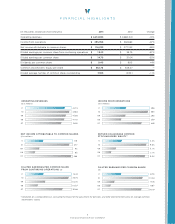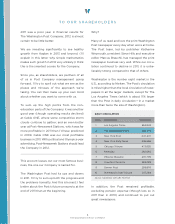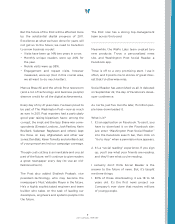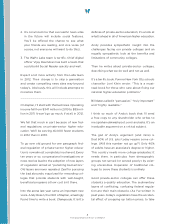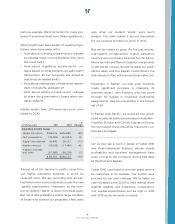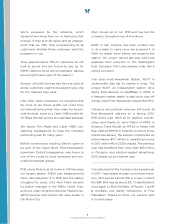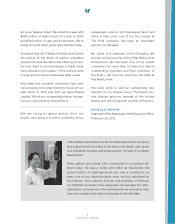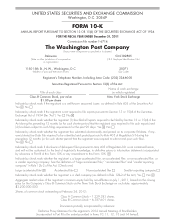Washington Post 2011 Annual Report Download - page 13
Download and view the complete annual report
Please find page 13 of the 2011 Washington Post annual report below. You can navigate through the pages in the report by either clicking on the pages listed below, or by using the keyword search tool below to find specific information within the annual report.
PART I
Item 1. Business.
The Washington Post Company (the Company) is a diversified education and media company. The Company’s Kaplan
subsidiary provides a wide variety of educational services, both domestically and outside the United States. The
Company’s media operations consist of the ownership and operation of cable television systems, newspaper publishing
(principally The Washington Post) and television broadcasting (through the ownership and operation of six television
broadcast stations).
Information concerning the consolidated operating revenues, consolidated income from operations and identifiable assets
attributable to the principal segments of the Company’s business for the last three fiscal years is contained in Note 18 to
the Company’s Consolidated Financial Statements appearing elsewhere in this Annual Report on Form 10-K, as required
by Item 101(b) and 101(d) of Regulation S-K. Revenues for each segment are shown in Note 18 gross of intersegment
sales. Consolidated revenues are reported net of intersegment sales, which did not exceed 0.1% of consolidated
operating revenues.
The Company’s operations in geographic areas outside the U.S. consist primarily of Kaplan’s non-U.S. operations. During
the fiscal years 2011, 2010 and 2009, these operations accounted for approximately 15%, 12% and 12%,
respectively, of the Company’s consolidated revenues, and the identifiable assets attributable to non-U.S. operations
represented approximately 15% and 13% of the Company’s consolidated assets at December 31, 2011, and January 2,
2011, respectively.
Education
Kaplan, Inc., a subsidiary of the Company, provides an extensive range of education and related services worldwide for
students and professionals. Kaplan conducts its operations through four segments: Kaplan Higher Education, Kaplan Test
Preparation, Kaplan International and Kaplan Ventures.
The following table presents revenues for the three years ended December 31, 2011, 2010 and 2009 for each of
Kaplan’s segments:
Year Ended December 31,
(in thousands) 2011 2010 2009
Kaplan Higher Education .......................... $1,399.6 $1,905.0 $1,653.3
Kaplan Test Preparation ............................ 303.1 314.9 336.8
Kaplan International .............................. 690.2 585.9 537.2
Kaplan Ventures ................................. 74.9 59.3 57.2
Kaplan Corporate and Intersegment Eliminations .......... (2.8) (2.8) (8.3)
Total Kaplan Revenue ........................... $2,465.0 $2,862.3 $2,576.2
Kaplan Higher Education
Kaplan Higher Education (KHE) provides a wide array of certificate, diploma and degree programs—on campus and
online—designed to meet the needs of students seeking to advance their education and career goals.
In 2011, Kaplan’s U.S.-based KHE division included the following businesses: Kaplan University and KHE Campuses.
Each of these businesses is described briefly below.
Kaplan University. Kaplan University specializes in online education, is accredited by the Higher Learning Commission
of the North Central Association of Colleges and Schools and holds other programmatic accreditations. Most of Kaplan
University’s programs are offered online, while some are offered in a traditional classroom format at 11 campuses in
Iowa, Maine, Maryland and Nebraska, and six Kaplan University Learning Centers and Education Centers in four
additional states. Kaplan University also includes Concord Law School, a fully online law school. At year-end 2011,
Kaplan University had approximately 44,000 students enrolled in online programs and approximately 5,800 students
enrolled in its classroom-based programs.
In early 2011, Kaplan’s Professional and Licensure business, which previously operated as part of Kaplan Test
Preparation, combined with Kaplan University’s continuing education business to form the School of Professional and
Continuing Education (PACE), a separate non-degree-granting school within Kaplan University. In connection with this
reorganization, PACE also integrated the Kaplan certification preparation business, which had previously operated under
Kaplan Ventures.
2011 FORM 10-K 1


